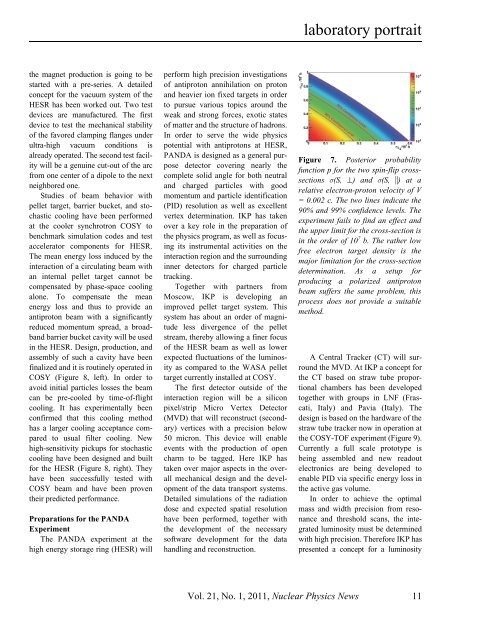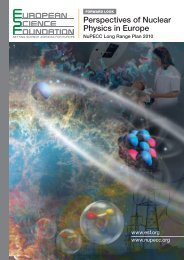Vol. 21 No. 1 - NuPECC
Vol. 21 No. 1 - NuPECC
Vol. 21 No. 1 - NuPECC
Create successful ePaper yourself
Turn your PDF publications into a flip-book with our unique Google optimized e-Paper software.
laboratory portrait<br />
the magnet production is going to be<br />
started with a pre-series. A detailed<br />
concept for the vacuum system of the<br />
HESR has been worked out. Two test<br />
devices are manufactured. The first<br />
device to test the mechanical stability<br />
of the favored clamping flanges under<br />
ultra-high vacuum conditions is<br />
already operated. The second test facility<br />
will be a genuine cut-out of the arc<br />
from one center of a dipole to the next<br />
neighbored one.<br />
Studies of beam behavior with<br />
pellet target, barrier bucket, and stochastic<br />
cooling have been performed<br />
at the cooler synchrotron COSY to<br />
benchmark simulation codes and test<br />
accelerator components for HESR.<br />
The mean energy loss induced by the<br />
interaction of a circulating beam with<br />
an internal pellet target cannot be<br />
compensated by phase-space cooling<br />
alone. To compensate the mean<br />
energy loss and thus to provide an<br />
antiproton beam with a significantly<br />
reduced momentum spread, a broadband<br />
barrier bucket cavity will be used<br />
in the HESR. Design, production, and<br />
assembly of such a cavity have been<br />
finalized and it is routinely operated in<br />
COSY (Figure 8, left). In order to<br />
avoid initial particles losses the beam<br />
can be pre-cooled by time-of-flight<br />
cooling. It has experimentally been<br />
confirmed that this cooling method<br />
has a larger cooling acceptance compared<br />
to usual filter cooling. New<br />
high-sensitivity pickups for stochastic<br />
cooling have been designed and built<br />
for the HESR (Figure 8, right). They<br />
have been successfully tested with<br />
COSY beam and have been proven<br />
their predicted performance.<br />
Preparations for the PANDA<br />
Experiment<br />
The PANDA experiment at the<br />
high energy storage ring (HESR) will<br />
perform high precision investigations<br />
of antiproton annihilation on proton<br />
and heavier ion fixed targets in order<br />
to pursue various topics around the<br />
weak and strong forces, exotic states<br />
of matter and the structure of hadrons.<br />
In order to serve the wide physics<br />
potential with antiprotons at HESR,<br />
PANDA is designed as a general purpose<br />
detector covering nearly the<br />
complete solid angle for both neutral<br />
and charged particles with good<br />
momentum and particle identification<br />
(PID) resolution as well as excellent<br />
vertex determination. IKP has taken<br />
over a key role in the preparation of<br />
the physics program, as well as focusing<br />
its instrumental activities on the<br />
interaction region and the surrounding<br />
inner detectors for charged particle<br />
tracking.<br />
Together with partners from<br />
Moscow, IKP is developing an<br />
improved pellet target system. This<br />
system has about an order of magnitude<br />
less divergence of the pellet<br />
stream, thereby allowing a finer focus<br />
of the HESR beam as well as lower<br />
expected fluctuations of the luminosity<br />
as compared to the WASA pellet<br />
target currently installed at COSY.<br />
The first detector outside of the<br />
interaction region will be a silicon<br />
pixel/strip Micro Vertex Detector<br />
(MVD) that will reconstruct (secondary)<br />
vertices with a precision below<br />
50 micron. This device will enable<br />
events with the production of open<br />
charm to be tagged. Here IKP has<br />
taken over major aspects in the overall<br />
mechanical design and the development<br />
of the data transport systems.<br />
Detailed simulations of the radiation<br />
dose and expected spatial resolution<br />
have been performed, together with<br />
the development of the necessary<br />
software development for the data<br />
handling and reconstruction.<br />
Figure 7. Posterior probability<br />
function p for the two spin-flip crosssections<br />
s(S, ^) and s(S, ) at a<br />
relative electron-proton velocity of V<br />
= 0.002 c. The two lines indicate the<br />
90% and 99% confidence levels. The<br />
experiment fails to find an effect and<br />
the upper limit for the cross-section is<br />
in the order of 10 7 b. The rather low<br />
free electron target density is the<br />
major limitation for the cross-section<br />
determination. As a setup for<br />
producing a polarized antiproton<br />
beam suffers the same problem, this<br />
process does not provide a suitable<br />
method.<br />
A Central Tracker (CT) will surround<br />
the MVD. At IKP a concept for<br />
the CT based on straw tube proportional<br />
chambers has been developed<br />
together with groups in LNF (Frascati,<br />
Italy) and Pavia (Italy). The<br />
design is based on the hardware of the<br />
straw tube tracker now in operation at<br />
the COSY-TOF experiment (Figure 9).<br />
Currently a full scale prototype is<br />
being assembled and new readout<br />
electronics are being developed to<br />
enable PID via specific energy loss in<br />
the active gas volume.<br />
In order to achieve the optimal<br />
mass and width precision from resonance<br />
and threshold scans, the integrated<br />
luminosity must be determined<br />
with high precision. Therefore IKP has<br />
presented a concept for a luminosity<br />
<strong>Vol</strong>. <strong>21</strong>, <strong>No</strong>. 1, 2011, Nuclear Physics News 11
















